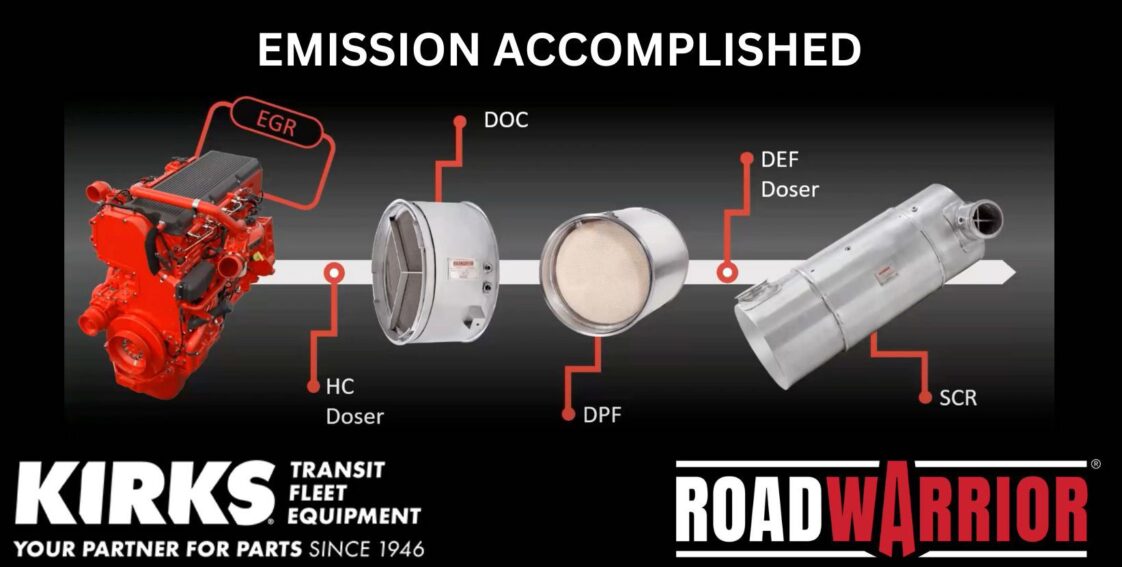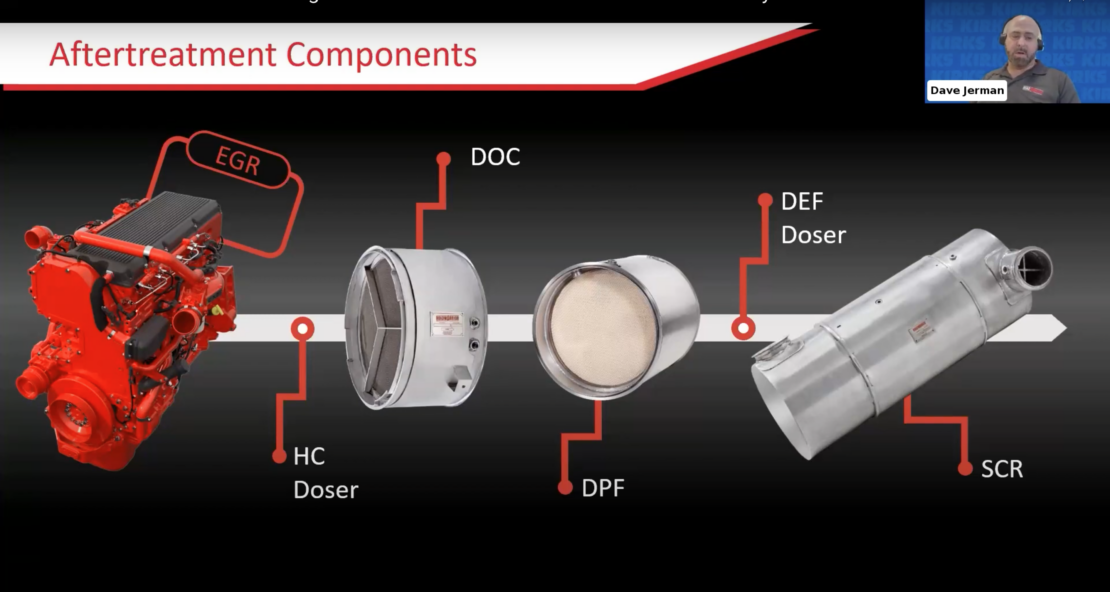
Emission Accomplished: RoadWarrior Shares Aftertreatment Expertise in Diagnostics and Maintenance of DPFs, DOCs, and SCR Systems
The sheer volume of laws and penalties around environmental emission standards require transit bus managers and technicians to always be on top of their aftertreatment game.
As part of the KIRKS Toolbox webinar series, we interviewed RoadWarrior’s Sales Director, David Jerman, who provided valuable insights on maintaining aftertreatment systems. He emphasized the importance of vigilance when maintaining these complex systems.
With a focus on controlling emissions, our discussion covered the critical tail-end parts of the emission system: Diesel Oxidation Catalysts (DOCs), Diesel Particulate Filters (DPFs), and Selective Catalytic Reduction (SCR) Systems.

Understanding the Aftertreatment System: DOC, DPF, and SCR Systems
Heavy-duty vehicle environmental compliance rides on the optimal functioning of several systems. These systems work collectively to reduce emissions and improve performance. Each plays an important role and depends on others to function.
Diesel Oxidation Catalyst (DOC): The Backbone of DPF Performance
A properly working DOC is essential to maintain efficient operations and avoid using too much fuel. Dave Jerman calls it the “backbone of DPF performance.” It uses various precious metals, such as platinum and palladium, as catalysts to do the job.
The DOC speeds up chemical reactions that change harmful pollutants into less harmful substances like carbon dioxide and water. Dave emphasized that a “healthy DOC promotes proper regeneration efficiency.”
Diesel Particulate Filter (DPF): Capturing Harmful Particles
Another critical piece of the emissions compliance ensemble is the DPF. This component filters out particulate matter from exhaust gasses. Crucial to reducing air pollution, DPFs effectively capture and prevent harmful particles from being released. However, the filter’s cleanliness determines its efficiency. With time, trapped particles can build up, reducing their usefulness and requiring a cleaning process known as regeneration. Correctly done, this procedure burns off trapped particles, restoring DPF performance.
Selective Catalytic Reduction System (SCR): Minimizing Nitrogen Oxide Release
Most heavy-duty vehicles have an SCR. The purpose of the SCR is to minimize Nitrogen Oxide (NOx) emissions. This system relies on a urea-based diesel exhaust fluid (DEF) injected into the exhaust stream. Enabling a catalytic reaction, the DEF combines with NOx particles to produce nitrogen and water vapor. These releases pose less environmental harm than their NOx counterparts.
Better Diagnostics of Aftertreatment Systems Provide Improved Performance
Technicians know it is not enough to simply replace a failing part. Finding solutions means diagnosing symptoms across many connected components.
The ability to rapidly diagnose true root causes brings extraordinary success. Making repairs quickly in the right areas minimizes downtime, lowers costs, and reduces the hassle on the shop floor. Your vehicles spend more time on the road, and your efforts maintain emission control system longevity.
Longevity requires optimizing end-to-end functionality, from exhaust gas recirculation to urea injection precision. Swiftly identifying and resolving issues across the emission stream provides the way. But doing so can be difficult.
Misleading Symptoms and Hidden Problems Challenge Aftertreatment Diagnostics
What makes diagnosis challenging is that misleading symptoms or hidden problems may lead technicians to perform trial-and-error replacements. Given the pressure to get vehicles back on the road, no one wants to waste time trying things. Management wants it fixed.
Aftertreatment Diagnostic tips for DOC and DPF issues from Dave at RoadWarrior
- Regeneration Cycles: You can gauge the health of an aftertreatment system by observing its regeneration cycles. Dave Jerman explained that often recurring regeneration is a telltale sign of underlying issues.
Understanding the vehicle’s regeneration cycle history begins with downloading and analyzing onboard control module data. Comparing out-of-line readings with an established healthy baseline is necessary for problem identification and resolution.
Watch the replay for Dave’s in-depth explanation of analyzing ECM Data of ReGEN History, temperature, pressure readings during forced REGEN, and testing Delta and Temp Sensors. - Smoke, Pressure, and Higher Hydrocarbon Emissions: A well-working DOC reduces costly fuel consumption. However, it can fail due to damage, clogged DPF filters, or lack of maintenance. Over time, the chemical reaction provided by the metal coatings fades. Symptoms of failing DOC include black smoke, system pressure, and higher hydrocarbon emissions. Frequent regeneration costs money and degrades engine efficiency, performance, and, eventually, your bottom line.
- High Temperatures: As the system’s “trash can,” Jerman says the DPF most commonly fails because of built-up soot. DPF failures also arise from excessive temperatures, which may cause a cracked filter. Typically, high temperatures come from over-revving the engine, driving too fast, or using poor-quality fuel.
- Clogged DPF: As engine hours accumulate, a clogged filter may cause the engine to lose power and operate inefficiently. This clogging can also lead to black smoke, a telltale sign that a filter needs cleaning or replacement.
Understanding root causes is fundamental to efficient fleet maintenance. Rushing to replace unneeded parts creates unnecessary expenses, does not address the real problem, and results in poor performance and higher transit maintenance costs.
Three Points of Inspection to Evaluate Damage to a DPF
RoadWarrior’s diagram below visually walks you through three points of inspection when evaluating the damage to a DPF:
- Visual Inspection
- Pin-Gauge Testing
- High-Lumen Light Test
Cautions With Replacing with Remanufactured DPFs and DOCs
While replacing a damaged DPF with a remanufactured DPF might seem budget-friendly, Dave Jerman advises caution. Unseen damage often harbors hidden costs and uncertain performance. He explains that third-party services might not thoroughly clean DPFs or heat them overnight to remove most particles.
Inadequate cleaning can cause potential harm to vehicle performance. Consequently, Jerman suggests that technicians clean the DPFs for the best possible results. Self-cleaning can guarantee the thoroughness needed and prove to be cost-effective.
Jerman advises prompt replacement for a damaged DOC, and no cleaning service can tell you that the chemical coating is still chemically active. Giving you a “clean bill of health” only provides a false sense of security. Internal damage cannot be found by visible inspection, only by costly third-party testing. Instead, replace the DOC when telltale signs point to its failure.
RoadWarrior Provides Fleet Emission DOC and DPF Solutions
Dave Jerman provided us with highlights of the deep knowledge and innovative diagnostic tools. As an industry leader, RoadWarrior offers high-quality replacement parts for efficient and reliable fleet maintenance.
KIRKS confidently promotes the RoadWarrior brand for the following outstanding reasons:
- Premium Metalcor® Catalyst Technology: RoadWarrior is the only manufacturer that uses this technology, embedded in all RoadWarrior DOCs and SCRs. It offers ten times the shock resistance over competitors. It also achieves the required operating temperature faster.
- This coating is fused to thinner, stronger catalyst substrates to guarantee maximum performance under the harshest conditions.
- Designed and produced in RoadWarrior’s own labs
- Every unit is inspected for quality
- Bonus Recycling Program: This novel program allows customers to earn hundreds or thousands of dollars by recycling their scrap DPFs and DOCs. According to Jerman, customers hail the recycling initiative for its impact on profitability and environmental sustainability.
- Mobile Diagnostic Decoder® (MDD): The MDD is a downloadable tool for managing fleet health. It clears soft codes, reads and updates the control module, initiates forced regens, and performs other functions.
- Filter Supply: filters for over a thousand OEM part number cross-references.
- Inventory and Distribution: North America’s most extensive inventory and distribution system.
- Fast Drop-Shipping: Nationwide warehouses can provide fast drop-shipping services for KIRKS customers in emergencies.
We know you can rely on RoadWarrior’s commitment to ensure more fuel efficiency, lower consumption of DEF, and long-term performance for your heavy-duty engine.
Equipping your Transit and Fleet Technicians with Know-how
Skilled technicians know that a single part failure can point to a broader issue. The onus falls on them to understand system complexities, find the causes, and apply the fix the first time.
KIRKS ToolBOX webinars, proprietary tools, equipment, and personal onsite training equips technicians with the knowledge to keep vehicles moving with optimal performance. Technicians and fleet managers can provide efficient and cost-effective maintenance when they understand their emissions systems’ complex operational patterns and health signals.
Teams can minimize the environmental impact, optimize fleet performance, and improve operational efficiency with full regulatory compliance when they know how to thoroughly maintain, replace, and clean parts.
DPFs and DOCs are innovative solutions for emissions control and add significant value by improving fuel efficiency. Share this link with your maintenance technicians to get the greatest return on your investment.
We are here to help you escape the parts trap. Contact us today and talk to a KIRKS product specialist. We are your partner for parts!
